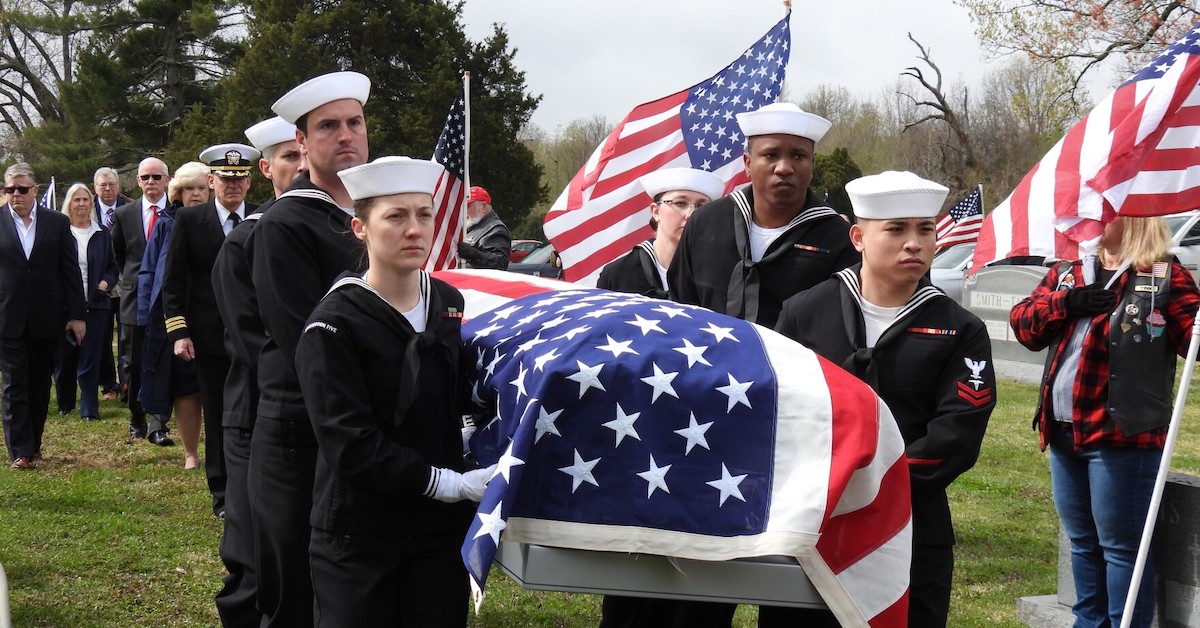After 82 years of absence, a sailor from Paducah killed at Pearl Harbor was finally buried on Friday.
More than 200 people, including family members, veterans and government officials, came to Maplelawn Park Cemetery to see Navy Firefighter 2nd Class Hal Jake Allison buried in his family plot alongside his parents – Henry and Opal Moore Allison.
A piper played “My Old Kentucky Home” as Allison’s casket was brought to the family grounds, where it received full military honors.
Allison left Paducah to join the United States Navy in 1940. He was assigned to the USS Oklahoma, one of the first ships to be hit by Japanese forces at Pearl Harbor on December 7, 1941. His family was notified by telegram in February 1942 that all attempts to locate him following the attack were unsuccessful. He was pronounced dead at age 21 and his remains remained unidentified for 81 years.
His body was among those identified by the USS Oklahoma Identification Project, which has tested the DNA of surviving family members to identify the remains of hundreds of Pearl Harbor victims since 2015. Pamela Bottoms, Allison’s niece, submitted her DNA to the project in hopes that he would bring his uncle home. They received the call in October 2021.
“We were so excited and it’s so wonderful to bring him home [be] with my grandmother who mourned her son [her] life. Every December 7, she would go to his room with his Bible and pray that he would come home somehow,” said Bottoms, who still lives in western Kentucky. “That’s what happens when you don’t have a body. Finally, we have a resolution. So now when I go out and put flowers – I do it for every occasion – now he will be there.
“We’ve had an empty grave there for him this whole time. It’s a miracle he’s home.
A total of 2,403 American servicemen and civilians died at Pearl Harbor. Now that Allison is back home, 33 other people from the USS Oklahoma remain unidentified. They are buried in a military cemetery in Honolulu.
Navy Rear Admiral Gene Price said ceremonies like this are rare in that they are both happy and sad.
“[The sailors at Pearl Harbor] probably thought [the sirens sounded during the attack] were a drill and some of them passed, but on the USS Oklahoma most of them didn’t because it was one of the first ships hit,” he said. told WKMS. “So most of these people died without even knowing what was going on, but they are going home. And it takes time, but the Navy finally brings them back to their place. »
No one at the service had ever met Allison, but several family and community members showed up to pay their respects. Michael Allison, Hal’s nephew, said he didn’t know much about his uncle, but he remembered a bit of family folklore passed down from his father. He said “every Christmas Day Uncle Hal used to break the ice – if there was any ice – on the Kentucky side of the [Ohio River] and swim to Illinois. Although Michael never met Hal, he couldn’t be happier to have found his way home.
“It’s an honor – that’s what it does,” he said. “It’s amazing what DNA testing can do…that after 80 you can find someone and bring them home.”
Amateur historian David Heathcott brought the original telegram that Allison’s family received informing them of their son’s disappearance, and Kathy Peeler brought a box of love letters from Allison to her mother, Irene Mayberry. She hopes the letters will bring the family closer to him.
“It’s history. The family needs this. These are from 1937 to March 1941. She kept them until the last one in this box,” she said. “If I hadn’t passed them on to people connected to Hal when I passed, no one would know who they belong to. Now they do and I hope it brings to life a time that is so long gone now.
Heathcott found the telegram in a scrapbook in Weakley County, Tennessee, and came into contact with the Allison family by chance through his work as a museum teacher at Discovery Park of America in Union City, Tennessee.
“My connection is visceral in a way. My uncle was killed in 1944 by a Japanese suicide bomber…We knew he wasn’t coming back. I found this and read this telegram and imagined that my great -father read it,” he said. “There’s just something powerful about such things that time doesn’t take. I tried my best to keep [Hal’s] living name. I know my uncle will never come home but somehow I guess I adopted Hal [as my uncle].”
For Sandi Reid, Allison’s great-niece, the experience of burying her was emotional and necessary.
“I think our family has just managed to always keep their name alive. Its important to me. It is important for my children. And it was passed down from my grandmother who kept her picture in her driveway all my life,” Reid said. “I grew up with him always being there in the stories…so we knew him, you know.”

